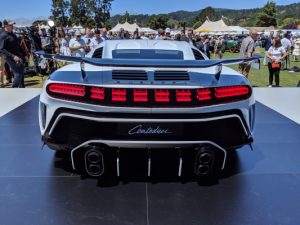Panasonic’s S1R got it first, but the A7R IV now has a 5.76 million dot OLED electronic viewfinder. The high resolution and reasonably fast 60 Hz refresh rate make it easy on the eyes, but the A7R IV will blackout during shooting, temporarily blocking your view, unlike the freshly announced A9 II. For the type of artistic shooting it’s designed for, though, this EVF is ideal, providing an accurate preview of what you’re about to shoot.
The rear touchscreen still doesn’t flip around, so vloggers can probably tune out if they haven’t already. It’s also under-utilized. You can only tap-to-focus and drag the AF point around or use the Touch Pad option to move the AF point with your thumb when looking through the EVF. There’s no option at all to control the main menus or even the quick-access Function menu, like you can on the Nikon Z 7 or Panasonic S1R.
As for those menus, they’re still the biggest weakness on Sony’s A7-series cameras. It’s tricky to find what you need as the category organization and navigation logic isn’t, well, logical. Your best bet is to set up the camera buttons and Function menu the way you want, then stay out of the menus as much as possible.
The A7R IV has two high-speed SD UHS-II card slots, unlike the A7R III, which only had one UHS II slot and a slower UHS I slot. As I found out during action shooting, it’s best to pay extra to get the fastest cards you can afford. With a 61-megapixel sensor, uncompressed RAW files are around 120MB and even JPEG files can hit 50MB in fine mode. If you want the best shooting and transfer speeds, I’d recommend a top-flight 300 MB/s SD card.
Things keep getting better on the connection side for Sony. The A7R IV packs a faster USB Type C 3.2 connector, along with HDMI, Micro USB, headphone and microphone ports. What’s new here is the Multi Interface Shoe that opens up digital audio connections. If you hook up Sony’s ECM-B1M shotgun mic or XLR-K3M XLS adapter kit, you’ll get professional audio quality that can match any dedicated camcorder.
On the negative side, the A7R IV does let you share pictures and shoot remotely using WiFi, Bluetooth and NFC, but you have to use Sony’s Imagine Edge Mobile app. With a 2.1 rating on the App Store, it’s one of the worst camera apps out there, and that’s saying a lot. It’s pain to connect the camera to your phone and it’s laggy and unintuitive to use. Most pros who would buy this camera probably wouldn’t use it, but still, Sony needs to do better here.
It uses the same Z-series battery as before, but now delivers 670 shots on a charge with the rear display, or 530 when using the EVF, according to official CIPA ratings.That’s a slight improvement over the A7R III (650 shots), but in the real world, I was able to shoot over a thousand shots. That’s a good thing because the A7R IV is capable of shooting a lot of photos in a short amount of time.
Performance
There were times when I found myself laughing in awe of what this camera could do. You would not expect a 61-megapixel camera to be fast, but the A7R IV really delivers 10 fps speeds with continuous AF and auto exposure, even when shooting compressed RAW and fine JPEG images. If you elect to shoot uncompressed RAW, it slows down a bit to 7-8 fps, but that’s still an astonishing speed considering the image sizes.
With fast UHS-II cards, I could shoot at those speeds for a surprisingly long time. That’s thanks to a buffer that can handle 68 compressed or 30 uncompressed RAW images — about 3.6GB worth of files — in a single burst. However, the buffer took quite a while to clear, sometimes well over 30 seconds. You can review images during that break, but many settings, like full-frame/APS-C switching are unavailable.
If that won’t cut it, a flick of a menu setting transforms the A7R IV into a 26-megapixel APS-C camera with a 1.5X crop factor. In that mode, I could capture 10 fps bursts for much longer (three times to be exact), making it more useful as an action camera. The crop mode also brings you closer to your subject, turning a 200mm lens into a 300mm lens. To top it off, the resolution is an added bonus for things like wildlife photography as you can crop in a lot while retaining detail.
That speed is useless without a good autofocus system, and that’s where Sony is so far ahead of everyone else. The A7R IV now has 567 phase-detect and 425 contrast detect AF points, compared to 425 phase-detect points on the A7R III. It has more coverage (74 percent horizontal and 99.7 percent vertical in full-frame mode) and a much faster Bionz X processor, as well. By comparison, Panasonic’s S1 only uses contrast-detect AF, and the Nikon Z 7 is limited to 493 phase-detect points with 90 percent coverage total.
All that tech helped me to keep fast-moving things in focus while shooting 10 fps bursts. If I kept the tracking dot on the subject, I rarely got an out of focus shot. With those smarts and virtually no lag, the camera often had me fighting to keep up.
Luckily Sony has a cheat for that with its otherworldly AI-powered Eye AF system for people and animals. When enabled, it’ll track your subject’s eyes even if they’re relatively far away and switch to face tracking when it can’t. If your subject moves out of frame or turns around, it’ll stay locked on their head or body and switch back to the closest eye as soon as it can.
It worked in most circumstances for me, even with busy scenarios like horse jumping. With Eye AF turned on, I was able to capture sequences of jumps using Sony’s 70-200mm f/2.8 telephoto lens without any worry about focus. Unlike earlier versions of Eye AF, it rarely lost track of its subject and was a lot more responsive. It wasn’t quite as good with the horse’s eyes, especially if they had shaggy fringes. The same applied to furry terrier-type dogs.
The A7R IV is not a sports or wildlife shooter, but the extra resolution lets you shoot a bit wider than you otherwise might, then crop in to get the ideal framing. I could even see some photographers being tempted away from the more costly action- and sports-oriented A9 II.







